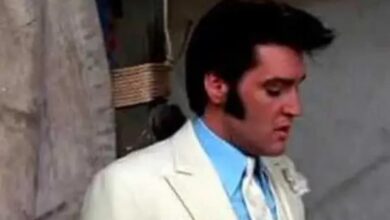Elvis at his peak: Women wanted him, men envied him, his presence was truly striking
Elvis Presley’s ’68 Comeback Special stands as a pivotal moment not only in his career but also in the history of rock and roll. Officially titled “Elvis,” the special marked his return to live performance after a period focused on movies rather than music. It was a carefully orchestrated event aimed at revitalizing his image and reconnecting with his roots as a live performer. At the heart of this landmark special was his electrifying impromptu jam session of “Baby, What You Want Me To Do,” originally recorded by blues legend Jimmy Reed in 1959.
The performance of “Baby, What You Want Me To Do” epitomized the raw energy and spontaneity that defined rock and roll in its purest form. Elvis, accompanied by a band of seasoned musicians, took the stage with confidence, strumming his guitar and belting out the opening lines with conviction. His powerful voice immediately captivated the audience, setting the stage for an exhilarating musical journey.
What set this performance apart was its unscripted nature. Unlike many of Elvis’s previous engagements, which were often meticulously choreographed, this jam session allowed for genuine improvisation and interaction between Elvis, his band, and the audience. This authenticity created an electric atmosphere, where every note and riff resonated with passion and excitement.
As the song unfolded, Elvis and his band demonstrated remarkable synergy. Each member contributed their unique musical prowess, enhancing the performance with intricate solos and dynamic rhythms. The musicians seamlessly transitioned between bluesy verses and high-energy instrumental breaks, showcasing their versatility and collective talent.
The audience’s response was immediate and enthusiastic, with cheers and applause punctuating each crescendo and climax of the performance. This interaction between performer and audience further fueled the intensity of the moment, creating an unforgettable experience that resonated long after the special concluded.
For Elvis Presley, the ’68 Comeback Special was more than just a musical performance; it was a statement of resilience and artistic prowess. It reaffirmed his status as a cultural icon and redefined his legacy in the annals of rock and roll history. Through his masterful rendition of “Baby, What You Want Me To Do,” Elvis showcased his ability to blend blues, rock, and soul into a seamless, electrifying sound that transcended genres and captivated generations.
Born on January 8, 1935, in Tupelo, Mississippi, Elvis Aaron Presley rose to fame in the mid-1950s, becoming a trailblazer of the rock and roll genre. His distinctive voice, charismatic stage presence, and pioneering musical style earned him a devoted global following. Hits like “Hound Dog,” “Jailhouse Rock,” and “Love Me Tender” solidified his reputation as a cultural phenomenon, influencing countless artists across diverse musical landscapes.
The ’68 Comeback Special not only marked a resurgence in Elvis’s career but also showcased his versatility as an artist. Beyond rock and roll, he delved into country, gospel, and blues, demonstrating a breadth of musical talent that resonated with audiences worldwide. His ability to connect deeply with listeners through his emotive performances and heartfelt lyrics ensured his enduring impact on popular music.
In retrospect, the impromptu jam session of “Baby, What You Want Me To Do” remains a defining moment in Elvis Presley’s career. It encapsulates the essence of his musical journey – from humble beginnings in Mississippi to global superstardom – and underscores his lasting influence on the evolution of rock and roll. The ’68 Comeback Special stands as a testament to Elvis’s enduring legacy and his ability to transcend musical boundaries, leaving an indelible mark on the world of music and culture.
As fans and music enthusiasts continue to revisit the ’68 Comeback Special and its iconic performances, including “Baby, What You Want Me To Do,” Elvis Presley’s status as the undisputed King of Rock and Roll remains firmly intact. His legacy continues to inspire new generations of artists and fans alike, ensuring that his music and influence endure for years to come.



